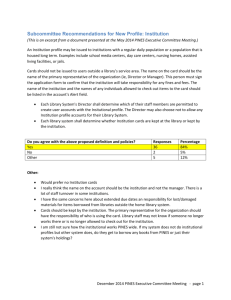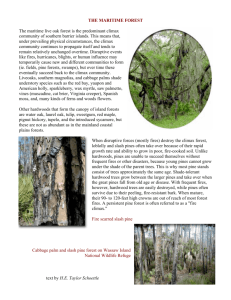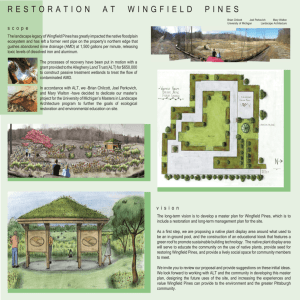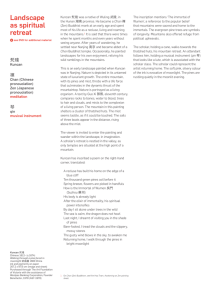BY RECOVERY OF YOUNG PONDEROSA PINES DAMAGED
advertisement
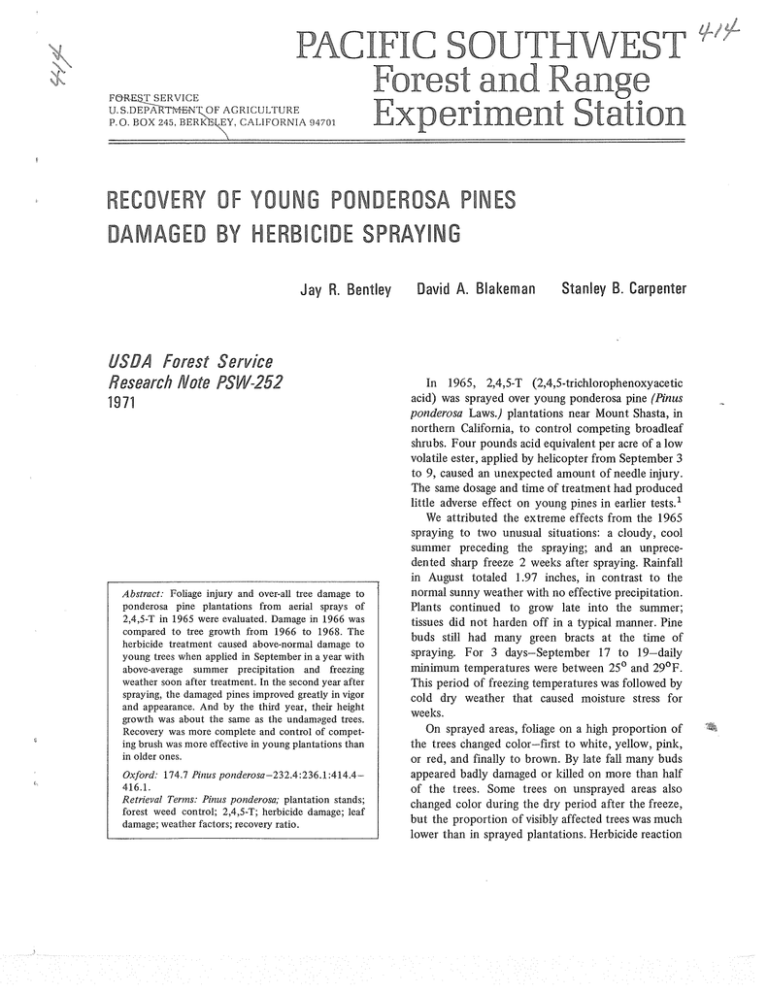
RECOVERY OF YOUNG PONDEROSA PINES DAMAGED BY HERBICIDE SPRAYING Jay R. Bentley Abstract: Foliage injury and over-all tree damage to ponderosa pine plantations from aerial sprays of 2,4,5-T in 1965 were evaluated. Damage in 1966 was compared to tree growth from 1966 to 1968. The herbicide treatment caused above-normal damage to young trees when applied in September in a year with above-average summer precipitation and freezing weather soon after treatment. In the second year after spraying, the damaged pines improved greatly in vigor and appearance. And by the third year, their height growth was about the same as the undam~gedtrees. Recovery was more complete and control of competing brush was more effective in young plantations than in older ones. Oxford: 174.7 Pinus ponderosa-232.4:236.1:414.4416.1. Retrieval Terms: Pinus ponderosa; plantation stands; forest weed control; 2,4,5-T; herbicide damage; leaf damage; weather factors; recovery ratio. David A. Blakeman Stanley B. Carpenter In 1965, 2,4,5-T (2,4,5-trichlorophenoxyacetic acid) was sprayed over young ponderosa pine (Pinus ponderosa Laws.) plantations near Mount Shasta, in northern California, to control competing broadleaf shrubs. Four pounds acid equivalent per acre of a low volatile ester, applied by helicopter from September 3 to 9, caused an unexpected amount of needle injury. The same dosage and time of treatment had produced little adverse effect on young pines in earlier tests.' We attributed the extreme effects from the 1965 spraying to two unusual situations: a cloudy, cool summer preceding the spraying; and an unprecedented sharp freeze 2 weeks after spraying. Rainfall in August totaled 1.97 inches, in contrast to the normal sunny weather with no effective precipitation. Plants continued to grow late into the summer; tissues did not harden off in a typical manner. Pine buds still had many green bracts at the time of spraying. For 3 days-September 17 to 19-daily minimum temperatures were between 2.5' and 29OF. This period of freezing temperatures was followed by cold dry weather that caused moisture stress for weeks. On sprayed areas, foliage on a high proportion of the trees changed color-first to white, yellow, pink, or red, and finally to brown. By late fall many buds appeared badly damaged or killed on more than half of the trees. Some trees on unsprayed areas also changed color during the dry period after the freeze, but the proportion of visibly affected trees was much lower than in sprayed plantations. Herbicide reaction 'a in the broadleblfed s h b s during fall was much greater than observed from Sepkmber spraying in most years of study. Leaves on the sprayed bmsh turned brown quicMy-equd to the brownhg t b t usually occurs during the next May or June. A much better than average kill of bmsh resulted from the 1965 spraying. The foliage injury that occurred in 1945 and the over-all tree damage present in 1966 were compaed with tree growth in 1964, 1967, and 1968. Four transects of 100 trees each-a sample of 400 treeswere set up in a plantation. The starting point of a transect was arbitrarily selected near the end of a tree row, and 10 consecutive trees were numbered 1 to 10. The transect then was offset two rows, and trees 11 to 20 were numbered. The offsets continued until trees 91 to 100 had been identified. Thus, each staggered trmsect was spread over 10 rows to avoid concentration of samples in any one row that might have been differentially affected by the plmthg or spraying procedures. Rating of foliage injury began in December 1965 and was completed the next spring. The amount of foliage remaining on each damaged tree was compared with the m o u n t remaining on nearby trees that appeared to be unaffected. These unaffected trees retained green and brown needles in about the same proprtion typicd of s m a r aged trees on unsprayed areas. Each tree was placed into one of two groups: (1) more than 50 percent of normal foliage, or (2) less than 50 percent of normal foliage. These groups were subdivided according to color and vigor of the remaining needles. Condition and size of terrninal buds also were recorded. Over-all damage to each tree was rated in August 1966 and August 1967, using the system developed during earlier studies of ground-~gspraying.' Five damage classes were used: None fo light-Pines show no visible effects of spraying, or the needles may show some discoloration or twisting but are not markedly stunted. A few lateral branches may show moderate damage. Moderate-Ternrinal whorl shows light to moderate effects. lateral branches have many shortened, discolored or twisted needles; but less than half of the branches have dead buds or greatly shortened new needles. Severe-Terminai whorl shows moderate to severe effects. More than half of the lateral branches have greatly stunted new needles or dead buds. Temiiacsl d e d - T e r ~ n a l bud is dead; lateral branches m y show light, moderate, or severe dmage. Dee dead-No signs of live tissue obsmed. Hei$t of each tree was measured before start of groa%rlh in 1966 and during late m m e r in 1966, 1967, and 1968. All hei&ts-up to tip of &best bud-were judgd to the closest inch. Effects of the herbicide an pines were siwnLla in plantations that had been planted in m y one year. The darnage d ~ f e r e dhowever, , between ages of pines at the time of spraying. Consequently, in reprtirag the results, we grouped the data accordhg to how old the pines were in September 1965: Age of Pknba- Rnes in total pines (yrs.) lions (No*) mmple (No.) Date of planting: Spring 1964 Spring 1962 Spring 1960 2 4 6 1 5 2 400 2,000 8W Two other plantation m p b d in. 1966 were dropped from the ies because reactions from 2,4,5-T were not typicd. In one plamt2ieion planted with pnderosa pine in 1959, the herbicide had little effect on either bmsh or pines. ikn another, where Jeffrey pine (Pinets jeffieyi Grev. & B&.) katd been planted in 1958, the herbidde was effective on the brush, but damaged pines only &&tly. This result was attributed to the greater re&tance of tanis species, as compared to that of ponderosa pine.' The degree of dmage to the pines was best &own by their over-all appearance in m m e r after spraying. Records of foliage h a g e duHing the winter of 196586 were of lirniled value. Most of the pines that Showed 'bone to light" or "moderate" s u m e r , had retained more than half of a normd needle crop in winter ( t b k I). Conversely, most of the pines that were dead by s u m e r had lost more than half of their needles in winter. Except for these broad conclusions, we found no condshnt rehationship between vigor of needles in whter and over-ad tree dmage apparent the newt s u m e r . Damage in the nlantations during the first s u m e r after spraying is suggested by the percent of pines in each damage dass (tcsbb I). In the 2-yeaeld plmtation only 43 percent of the pines showed "none to light9' or "moderate" damage, as compxed to 69 Table 1-Pine damage in 1966 related t o amount of needles remaining on the pines during winter after spraying, by age of pines at the time of spraying Tree damage class - August 1966 Normal needle crop Terminal Tree remaining in winter, None to dead dead Moderate Severe light 1965-66 (pct.) All classes Percent of pines in sample 2-YEAR-OLD PINES > 50 < 50 20 Total 20 21 2 11 23 11 20 10 16 71 29 30 16 100 17 5 100 4-YEAR-OLD-PINES Total 1 33 35 10 6-YEAR-OED PINES > 50 < 50 19 1 31 2 18 5 15 7 1 1 84 16 Total 20 33 23 22 2 100 'Less than 0.5 percent of sample. percent of the 4-year-old pines and 53 percent of the 6-year-old pines. Percent of the 1965 pine stand that was dead in 1966 was greatest for the younger pines. The most obvious effects from spraying were shown by the percent of trees severely damaged and of trees with dead terminals. The severely damaged pines had many dead branches, and on other branches the needles were stunted and discolored. These effects were most apparent in the 6-year-old pines because of their much greater size at the time of spraying. Recovery of Pines in 1967 In each plantation in 1967, most of the pines produced new foliage m d buds judged as normal in appearance. Thus, the over-all damage ratings improved greatly between 1966 and 1967 (fig. 1). The pines with "moderate" damage in 1966 were rated "none to light" damage in 1967. On most pines with dead terminal in 1966, new leaders were developed by 1967. Many of these trees, especially the younger pines, were growing vigorously in 1967. The improved damage ratings in 1967 represent improved vigor of most trees. However, these ratings do not indicate the number of pines showing some change in form caused by the herbicide damage. Most, if not all, of the trees rated "severe" or "terminal dead" in 1967 were at least slightly deformed. Lateral branches were missing on some of Damage Rating Class Percent of Total 2- year-old '* 4-year-old Figure 1-Changes in appearance of pines, as shown by damage ratings, between 1966 and 1967. the trees with "moderate" rating. These longer lasting effects of spraying were much more apparent in the 6-year-old pines than in those that were younger and smaller at the time of spraying. In each plantation the degrees of damage were summarized according to pine height at the time of spraying in 1965. Damage to the tallest 25 percent of the stand-the trees that had grown most vigorously and were most likely to be dominant in the futurewas analyzed separately. The shortest 25 percent and the intermediate 50 percent of the pines were also analyzed separately for damage. The dead pines were concentrated in the shortest groups (table 2). In the older plantations, killing of the terminal bud was more common in the tallest group. However, except for the much greater mortality in the shortest group of 2-year-old pines, damage classes between height groups showed no marked differences. Growth of Pines by Damage Classes The major effects of spray damage on growth of pines occurred during the first year after spraying (fig. 2). By the third year (1968), the average yearly growth was about the same for all damage classes I Table 2-Damage t o ponderosa pines as related t o height o f trees at the time of herbicide spraying, b y age of pines when sprayed . Extent of damage in August 1966 Heights of pines in 1965 None t o light Moderate I Shortest Intermediate Tallest All heights Severe Terminal dead Tree dead Percent o f pines in sample 2-YEAR-OLD PINES 22 20 31 23 14 11 29 30 16 4-YEAR-OLD PINES Shortest Tallest All heights 34 35 32 33 10 10 22 6-YEAR-OLD PINES 16 Tallest 29 33 23 22 within a plantation. Growth rate differed, of course, for pines of different ages. 2-year-old pines / 4-year-old pines Figure 2-Heights and growth of pines, 1965-1968 by 1966 damage classes. Damage Rating 'class The heights and yearly growth of pines that were 2 years old at time of spraying were: 1965 ht. Yearly growth (inches) (inches) 1966 I967 1968 Damage class (1966): None to light Moderate Severe Terminal dead Tree dead 6 6 6 5 1 4 3 1 1 4 3 3 3 5 4 4 4 The terminal whorl was already dead at the time of spraying on more than one-fourth of the 2-year-old pines. On these plants the remaining live lateral buds were only about 1 inch above the soil surface. Most of these tiny plants were in the "tree dead" damage class in 1966, but some survived and grew well in 1968. The pines in the "terminal dead" class were taller plants with a living terminal bud at the time of spraying. Most of the damaged 2-year-old pines that were alive in 1966 recovered rapidly and appeared to be growing normally by 1968. Heights and yearly growth of 4-year-old pines, by damage classes, were : 1965 ht. Yearly growth (inches) 1967 1968 (inches) I966 Damage class (1966): None to light Moderate Severe Terminal dead Tree dead 19 18 17 19 13 9 6 5 0 'I 6 5 6 8 7 6 7 The 4-year-old pines with "moderate" or "severe" damage lost a few more inches of height growth in 1966 than pines with "none to light" rating. On most plants with "terminal dead" rating, none of the lateral branches had developed as new leaders in 1966. New leaders developed by 1967, and height growth was near normal in 1968. A few of these plants developed double leaders and required pruning in 1967. By 1968, the effects of spraying were not noticeable except on the few most severely damaged trees, which had made up about 2 percent of the stand in 1967 (fig.I). In contrast to the s w a r results in all of the 4-year-old plantations, the degrees of damage and the yearly growth rates differed between the two 6-yearold plantations. At the time of spraying, the pines in plantation 6A averaged more than 10 inches taller than the pines in 6B. Plantation 6A is on a flat area below the other plantations. The pines there appeared to be less dormant on the date of spraying than pines elsewhere. And they appeared to be more damaged than trees in plantation 6B. In the 400-tree samples, 112 trees showed "severe" damage in 6A, but only 69 trees in 613. However, terminal buds were killed on only 47 trees in 6 8 compared to 106 trees in 6B. Pruning of double leaders caused by spray damage was needed in both plantations. Pine heights and yearly growth rates, by 1966 damage classes, for the 6-year-old plantations were: 1965 ht. Yearly growth (inches) 1967 1968 [inches) 1966 6A 6B 6A 6B 6A 6B 6A 6B Damage class (1966): None to light Moderate Severe Terminal dead Tree dead 53 43 12 12 54 44 10 11 5 6 4 7 8 9 58 46 -3 2 3 4 3 - -3 - 8 9 7 8 8 8 10 10 - 5 5 5 6 - 8 8 8 9 - The "severe" and "terminal dead" damage classes were concentrated among the taller pines in each plantation. Dead trees mainly were among the shorter pines in 6A, but were included in all pines in 6B. By 1968, the yearly growth rate in both plantations was relatively low for the pines with "none to light" damage in 1966. This difference could have been caused in part by excessive competition from dense stands of brush plants that had been growing rapidly in 1965, the year of spraying. The brush was only partially controlled by the single herbicide application, particularly in 6A where the stand was dominated by tall plants of bittercherry (Pmnus emarginata Dougl.). Other factors could have contributed to the slow height growth of pines in 6A, which averaged only 5 inches in 1968. T h s low-lying plantation was more affected than the other plantations by cold weather during one winter and by insect damage to the foliage in 1968. StocE~llgand S w i v d of Pines Stocking of pines in 1965 (table 3) was related closely to density of planting. The 295 pines per acre in the Zyear-old plantation represented 81 percent survival from an original spacing of 10 by 12 feet. Average stocking of the 4-year-old pines equaled 85 percent survival; and for the 6-year-old pines, the average survival had been 82 percent. By 1968, pine stocking in the 4-year-old and 6-year-old plantations still showed only slight effects of spraying; it averaged 81 percent of the number planted. In the Zyear-old plantation, however, the 1968 stocking was down to only 68 percent of the original planting density. Even so, the lower number of pines per acre, as compared to the older plantations, was caused more by low planting density than by spray damage. - Table 3-Effects of spraying on survival and growth of pines, by age and height of pines at the time of spraying Pine height group in 1965 Pine stocking 1965 / 1968 Average Average pine height pine growth 1945 1 1968 1965-1368 No. per acre Inches Inches 2-YEAR-OLD PINES Shortest Intermediate Tallest All heights , 74 147 34 144 1 5 12 15 11 10 52 38 13 20 25 20 72 28 22 4-YEAR-OLD PINES Shortest Tallest All heights 116 465 111 440 27 18 6-YEAR-OLD PINES Shortest Intermediate Tallest All heights 140 560 138 549 68 50 DISCUSSION AND CONCLUSIONS Although the plantations showed extreme needle damage a few weeks after spraying in early September 1965, the general appearance of the pines had improved greatly by August 1967. Examinations of needle damage during fall and winter after spraying were of little value in judging the damage caused by the herbicide. But a more critical evaluation of spray damage could be made at the end of the first growing season after spraying. Much of the damage observed at that time was not long lasting however; growth of new needles and buds was normal on most of the pines by the second year. These conclusions also were drawn from general observations of ponderosa pine plantations sprayed in other years when damage from 2,4,5-T applied in September was much less than occurred at Mt. Shasta in 1965. The limited damage typically was spotty and could be traced to uneven spray application. Mortality was negligible, and almost all of the damaged trees recovered by the second year. The high mortality rate in the 2-year-old plantation that was sprayed in 1965 is not the typical result from spraying 2,4,5-T after buds are dormant. Pine seedlings still alive at the end of the second year ordinarily have more than one branch, and will survive even though much of the foliage is damaged. The exceedindy small seedlings that had only one or two basal branches in 1965 were easily killed if they received an overdose of herbicide. Yet, the small seedlings that were still alive in I966 put on about as much height growth by 1968 as did the 2-year-old seedlings that were taller and had more foliage at the time of spraying. Effects of the 1965 herbicide application on height growth of pines was dete growth of the more severely damaged trees with growth of trees showing "none to light" damage in 1966. This approach appeared sound; there was no indication that growth rate of the undamaged pines had been altered-either stimulated or retarded-by the herbicide treatment. Color and vigor of the undamaged trees appeared to be the same as that of unsprayed pines. Growth of moderately damaged pines was not greatly affected during the 3-year period, 1966-68. Severely damaged trees lost about 1 year of growth. The total loss in height growth was of little importance in the younger plantations, where trees were putting on small height increment each year. The effects of spraying on appearance of the plantation also were less long-lasting in the 2-year-old and 4-year-old plantations than in the 6-year-old plantations. The younger plantations in 1970 showed little effect on tree form that could be directly attributed to herbicide damage. In contrast, many of the taller pines in the 6-year-old plantations were still poorly formed, primarily because of missing branches that had been killed by the herbicide. The pines in the younger plantations recovered well after suffering damage that was much greater than usually occurs from application of 2,4,5-T in September. The good control of brush obtained from the 1965 spraying should promote growth of the pines.2 In contrast, the pines in the older plantations did not recover so fully, particularly the taller pines that ordinarily would be kept as crop trees. Compekg brush was poorly controlled. The abnormal damage from spraying in 1965 may well have offset any beneficial effects from the herbicide application. These results support earlier conclusions that herbicides, if used, are best applied when brush plants are small and most easily killed.3 The herbicide can be applied before the pines have been planted or while they are still small. NOTES ' ~ e n ~ Jay e ~ R., , and Kenneth M. Estes. Effects ofherbicides applied by pound-ri.. sprayers on young pines. 1969. (GnPublisked-~S.on Fde, PacSc SW. Forest & Range Exp. Sta., Berkeley, Calif.) 2 ~ e n t l e y , Jay R., Stanley B. Carpenter, and David A. Blakeman. Early bmsh control promotes g~ow2.ho f ponderosa pine planted on a bulldozed site. USDA Forest Sew. Res. Note PSW-238, Pacific SW. Forest & Range Exp. Sta., Berkeley, C&. p., Pus. 1970. 3~entley,Jay R., and Kenneth M. Estes. Use of herbicides on timber plantations. California Region, Forest Sew., San Francisco. 4 1 p. 1965. The Author JAY R. BENTLEY was formerly supervisory range scientist assigned to fuel-break studies, with headquarters in Berkeley, Calif. He joined the Station staff in 1933-after earning a B.S. degree at Kansas State University-and retired in 1971. DAVID A. BILAmWIdW is a forestry graduate of the University of California (B.S., 1966; MS., 1970). Formerly with the fuel-break studies, he is now assigned to the Station's measurement techniques studies, at Berkeley. STANLEY B. CAWENTER was formerly assigned to fuel modification studies, at Berkeley. He earned. forestry degrees from the University o f I d a h o (B.S., 1959) and the University of Was7ashingon (M.F., 1961). This publication reports research involving pesticides. It does not contain recommendations for their use, nor does it imply that the uses discussed here have been registered. All uses of pesticides must be registered by appropriate State and/or Federal agencies before they can be recommended. CAUTION: Pesticides can be injurious to humans, domestic animals, desirable plants, and fish or other wildlife-if they are not handled or applied properly. Use all pesticides selectively and carefully. Follow recommended practices for the disposal of surplus pesticides and pesticide containers. GPO 9S1-751 The Forest %mice of the U.S. Dep . . . Conducts forest and range research at more than 75 locations from h e r t o Rim to Alaska and Hawaii. . . . Participates with all State forestry agencies in cooperative programs to protect and irnprove the Nation's 395 million acres of State, lwal, and private forest lands. . . . Manages and protects the 187-million-acre National Forest System for sustained yield of its many products and services. T k Pacific %nthwest Fored and Range Expedment Sb&on represents the research branch of the Forest Service in California and Hawaii.

